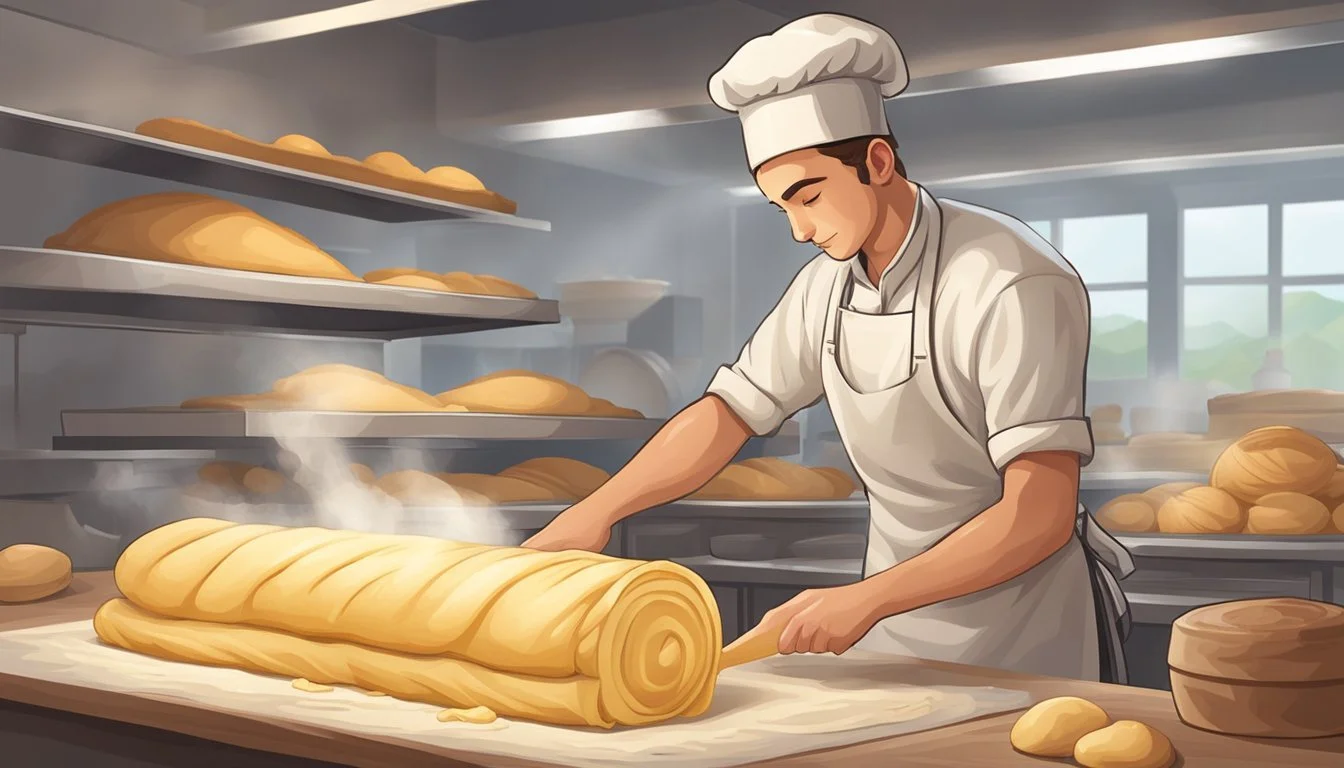Sourdough Croissants
The Artisanal Journey of Crafting Flaky Perfection
Sourdough croissants represent a unique blend of two artisan baking traditions: the tangy fermentation of sourdough and the delicate layers of croissants. These pastries are a true testament to the patience and skill of the baker, as they combine the slow fermentation process of sourdough with the meticulous technique of creating buttery, flaky layers in classic French croissants. The result is a pastry that not only offers the characteristic sourdough flavor but also boasts an incredibly tender and layered texture.
Creating sourdough croissants is an intricate process that begins with a lively and active sourdough starter, which acts as both a leavening agent and a flavor base. The dough is then mixed with high-quality butter and carefully laminated to achieve the many layers croissants are known for. Precision is crucial throughout this period, as the dough must maintain a balance between elasticity and firmness to ensure the final product has distinct, airy layers. The process is time-consuming, typically spanning several days, but for those who appreciate the art of baking, the effort is a rewarding journey.
Bakers often approach the task of making sourdough croissants with respect for the traditional methods, while also bringing their own nuances to the recipe. The addition of sourdough starter to the dough not only imparts a depth of flavor but also contributes to a more complex texture. These croissants are a labor of love that yields a rewarding and gourmet experience, appreciated by both amateur bakers and connoisseurs alike.
Understanding Sourdough
Sourdough is an artisanal bread product known for its characteristic tangy flavor, chewy texture, and crisp crust. The key ingredient in sourdough is the starter, a fermented mixture of flour and water that contains wild yeast and lactobacilli bacteria. Unlike commercial yeast, the natural yeast in a sourdough starter is present in the environment, capturing a unique blend of microorganisms.
Fermentation: This natural process occurs as the yeast and bacteria in the starter break down carbohydrates in the flour, producing carbon dioxide, alcohol, and organic acids.
Active Sourdough Starter: A mixture that has been fed with flour and water and allowed to ferment until it's bubbly and has doubled in size, indicating it's ready to leaven bread.
Leavening: The active starter is the leavening agent in sourdough, as it helps the dough rise due to the production of carbon dioxide during fermentation.
To maintain an active sourdough starter, one must regularly "feed" it with fresh flour and water. The process involves discarding a portion of the starter and replenishing it, which keeps the yeast active and ready to bake with.
When making sourdough croissants, bakers rely on a fully active starter to achieve the desired rise and layered texture. An active starter is characterized by a frothy, bubbly appearance and a pleasant, slightly sour aroma—indicative of successful fermentation. It’s essential for the baker to understand the fermentation process and the behavior of their starter to consistently produce high-quality sourdough baked goods.
Crafting the Croissant Dough
Crafting the perfect sourdough croissant dough involves a delicate balance of ingredients and precise technique. From mixing to the final bake, each step contributes to the final texture and flavor of this traditional pastry.
Ingredients
Flour: All-purpose flour is commonly used for its balance of strength and tenderness.
Levain: An active sourdough starter adds the unique sourdough flavor.
Liquids: A combination of water and whole milk provides moisture.
Fat: Butter is key for lamination and taste.
Flavor Enhancers: Sugar and salt are added for taste.
Mixing and Kneading
Combine the flour, sugar, salt, water, and milk in a stand mixer with a dough hook attachment. Knead until a rough dough forms. Kneading develops the gluten structure essential for a strong and pliable dough.
Incorporating the Levain
Mix the active starter into the dough until evenly distributed. The levain is responsible for the fermentation and rise of the dough.
Resting and Bulk Fermentation
After kneading, the dough must rest at room temperature to begin bulk fermentation, which develops the dough's flavor and structure.
Laminating the Dough
Lamination is a folding technique that creates thin layers of dough separated by butter. This process gives croissants their characteristic flaky layers.
Pre-Shaping and Shaping
Once laminated, the dough is divided and shaped. Croissants are typically cut into triangles and then rolled into their classic crescent shape.
Baking the Croissants
Bake in a preheated oven, which should be hot and preferably include steam. The ideal temperature for baking croissants is around 200-220°C (390-430°F). Steam helps create a crispy crust.
Sourdough Croissants Varieties
Besides plain croissants, dough can be filled with chocolate or other ingredients to create a range of pastries, such as chocolate croissants, tarts, or Danish pastries.
Serving and Storing
Serve croissants fresh or store them at room temperature. For long-term storage, freezing is recommended.
Advanced Techniques and Tips
For a superior texture and flavor, a long, slow fermentation is preferred. Precision in lamination and temperature control during baking are crucial.
Common Problems and Troubleshooting
Issues with texture or lack of layers often arise from improper lamination or fermentation. Proper resting and careful handling of the dough can prevent many common problems.
Incorporating Sourdough Into Other Pastries
Sourdough starter can be used in other pastries such as brioche, tarts, and cinnamon rolls for a distinctive sourdough twist.


